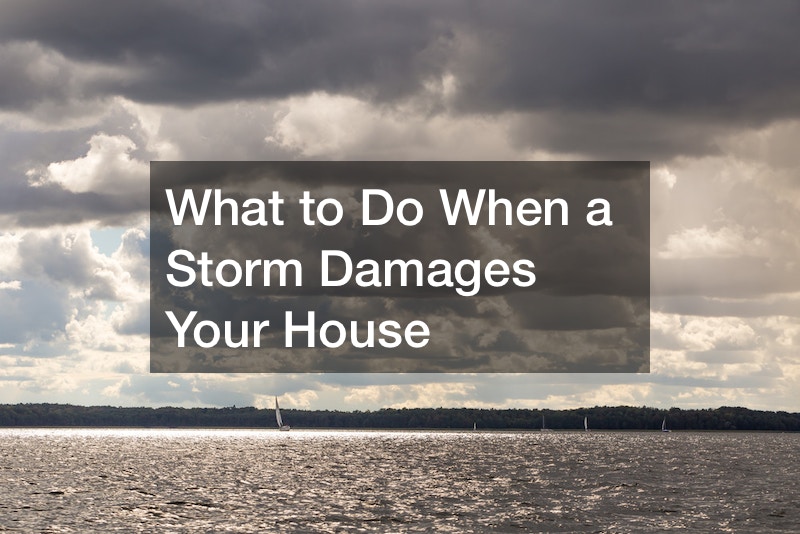
A storm can be a very frightening event, so what to do when a storm damages your house? The wind can howl and the rain can beat down on your home, making it feel like it is under attack. If the storm is bad enough, it can cause damage to your home. This can be a very stressful event, but there are some things that you can do to help ease the stress.
If you don’t know what to do when a storm damages your house, don’t panic – there are steps you can take to get your home back in order. First and foremost, if your roof is giving you issues, make sure to make roofing insurance claims on your real estate as soon as possible. They will need to assess the damage and determine what needs to be done in order for you to receive compensation. Once your insurance company is aware of the situation, they will likely send out a representative to take pictures and assess the damage.
Next, make sure to gather all of the necessary documents. This includes photos of the damage, copies of your insurance policy, receipts for any repairs or replacements made, and any other relevant information. Once you have all of this information, it will be easier to settle what to do when a storm damages your house, for your insurance company to process the claim.
Another part of what to do when a storm damages your house is to clean up the damage as best you can. This includes removing any debris that has fallen from the roof or walls, cleaning up any water damage, and fixing any broken windows or doors. Make sure to call a professional, perhaps to a water damage cleanup business, to help with this cleanup if necessary.
Start a Claim

The first step of what to do when a storm damages your house begins with a claim. Contact your insurance company and start an insurance claim. Insurance companies are obligated to pay out on qualifying claims, so they will want to know as much information about the storm as possible. They may ask you for photos or videos of the damage, eyewitness accounts, and even maps or aerial photographs of the area. Once you have contacted your insurance company and started your claim, it’s important to keep documentation of all progress made – this includes copies of all correspondence with your insurer, any bills received from contractors or vendors hired in connection with the cleanup process, and photos or videos documenting any repairs or upgrades made to your home after the storm.
Once you have started your insurance claim, you can begin the process of assessing the damage to your home. What to do when a storm damages your house and your storm doors in your home? It’s important to take care of all the little details so you don’t end up in over your head. Here are some tips to help you through the process:
- Contact your insurance company right away! Start a claim and make sure you have all of the paperwork ready to go.
- Inspect the Damage Once You’ve Called Your Insurance Company
What to do when a storm damages your house and there is minor damage on your storm windows that don’t need repairs or replacement? Be prepared to offer your insurer a written estimate of what needs to be done and when it will be completed. However, if there is major structural damage or something was lost during the storm, your warranty may not cover any expenses at this time, and you may need to speak with a storm proof screen manufacturer for replacement, installation, or storm damage cleanup services.
Set Deadlines for Repairs Once You Know What Is Covered By Your Insurance Policy

Damage caused by severe weather can often require extensive repair work which could take weeks or even months – set deadlines for when specific tasks should be completed in order to avoid frustrating both you and your contractor(s). For example, having windows replaced within three days of a covered loss can minimize disruption while also ensuring that replacements are made as quickly as possible during cold weather seasons when windows tend not to fit tightly together once they’re installed outside. Many insurers will tell you what to do when a storm damages your house and will pay for approved contractors who have carried out similar jobs before – working with someone who has experience clearly reduces stress levels right off the bat.
A fire caused by lightning is often considered to be the most dangerous of all the types of storm-related damage, as a direct hit from a bolt of lightning often initiates it. Thanks to advances in weather forecasting, and changes in our technological capabilities, lightning fatalities are becoming increasingly rare – but when it does happen, it’s much more likely that you’ll experience a house fire instead. The truth is that fires caused by lightning are very difficult to extinguish – no matter how thorough your emergency procedures are.
Significant hail can cause structural damage to both your property and cars parked outside – and hail storms can often contain plenty of smaller stones too – so it pays to know which hail impacts your specific insurance policy before leaving the house on a stormy day.
Cleanup Process

Once you have assessed the damage, it is time to begin the cleanup process. You will probably want to start by cleaning any areas that are damaged on the outside of your house as well as any areas that may have leaked water or windblown debris into your home. Once these areas have been cleaned, you may need to move furniture and clean up any damages that were caused by the storm. Additionally, you should remove any objects or materials that may have been blown onto roofs or into gutters and downspouts, that a roof cleaning service could assist with. Finally, you should check for downed power lines and make sure they’re properly secured before continuing with your cleanup.
After the initial cleanup is complete, you can begin repairs or replacements on damaged items. Check for damage to the exterior of your house. After the initial cleanup is complete, it is time to begin repairs or replacements of damaged items. It is important to remember to check for damage to the exterior of your house. This includes checking for broken windows, roofing damage, and damage to the foundation. If you find any damage, make sure to call a professional to assess and repair the damage.
Check for damage to the interior of your house – It is important to check for storm damage inside your home before starting the cleanup process. Roofing, windows, and doors can be damaged if they fall off their hinges or are blown out of their frames. Check for water infiltration as well. Your walls, ceilings, and floors may have been wet from the storm surge or rain and will need dryness treatment before painting or refixing.
It is important to check for storm damage inside your home before starting the cleanup process. Roofing, windows, and doors can be damaged if they fall off their hinges or are blown out of their frames. Check for water infiltration as well. Your walls, ceilings, and floors may have been wet from the storm surge or rain and will need dryness treatment before painting or refixing. Prepare your yard for additional plants or trees – Locate any trees, bushes, or other large objects from your yard and remove them from the yard. If you have any trees in your yard, make sure you have any power lines secured prior to further storm damage or cleanup.
Locate any trees, bushes, or other large objects from your yard and remove them from the yard. If you have any trees in your yard, make sure you have any power lines secured prior to further storm damage or cleanup. Treat the water-damaged area by trying to dry and disinfect the area where water has entered the house as soon as possible. If you are able to disinfect the water, be sure to follow all steps. If you are unable to disinfect the water, try to dry it out to reduce the amount of damage.
Check for damage to your belongings – If you have any items that were damaged in the storm, it is important to check them for damage. Many things can be replaced outright if they are damaged too badly, but other items may need repairs before they can be used again. For instance, a window may need a new screen or window frame, while furniture may need cushions or dents fixed, and common residential cleaning can help keep these tasks organized. If you find any damage to your belongings, make sure to take pictures and record the serial numbers so you can file a claim if necessary.
Check for damage to your property – It is likely that you will require professional assistance to clean up the mess caused by a storm. However, it is important to start cleaning as soon as possible in order to avoid potential health hazards. Begin by checking for damage to your property. This includes checking for broken windows, damaged roofs, and blown-down trees. If you find any damage, please contact your insurance company or emergency services so that they can assess the situation and set up a claim process.
Depending on the extent of the damage, some repairs may need to be left to professionals. If you live in an area that is prone to storms, it is important to have insurance in place to cover any damage that may occur. If you are the victim of a storm, be sure to check for damage to your property. Depending on the extent of the damage, some repairs may need to be left to professionals. If you have any questions about storm damage cleanup or insurance claims, be sure to contact a professional.
Preventative Maintenance

Finally, once all repairs are complete, you can focus on preventing future damage by taking steps such as installing hurricane shutters or storm doors. Damage caused by a storm can seem insurmountable, but with the help of a skilled professional, you can ensure that your home remains safe from future damage. Here are some tips for repairing after a storm:
- Make sure to document all damages in detail, both before and after the storm. This will help expedite repairs if necessary and allow you to make an insurance claim if necessary.
If you live in an area prone to hurricanes or tropical storms, be sure to install hurricane shutters or storm doors on your windows and doors as soon as possible. These measures will keep wind and rain out of your home while providing protection against vandalism or theft should the storm cause significant damage outside your home. Clean up any water accumulations inside and outside your home as quickly as possible; prolonged exposure can lead to mold growth and other health hazards. If you cannot clean up flooding yourself, consider calling in a professional clean-up service.
Finally, don’t forget about regular maintenance by keeping your gutters clear of debris and maintaining roofs and siding, you’ll help prevent further damage in the event of another bad weather event. After a storm, the most important thing you can do is to stay calm and begin the process of assessing the damage and cleaning up your home. Contacting your insurance company as soon as possible is crucial in getting the claims process started. Depending on the severity of the damage, some repairs may need to be completed by professionals. By taking these steps, you can get your home back in order after a storm.
If you are not in a position to hire a handyman to help you out, consider visiting local centers and social service organizations for assistance. Many of these organizations, especially those that are open to the public, provide free or low-cost services to help their community during times of crisis or natural disaster.
If you are living in a flood-prone area, especially near the ocean, it is important that you put together a storm kit for any future storms that you may experience. You should have several weeks’ worth of food and water that is easy to prepare. You should have bottled water that is easy to transport in an emergency, first aid supplies, matches, candles, flashlights, etc. Also, be sure that you have a manual can opener on hand in case the power goes out.
Maintaining a home is something that many people may want to do once they retire, but maintaining your home properly in the early years is necessary for the peace of mind that it will last that long. These are only a few ideas that you can use to insure that your home is protected and that you will have fewer issues in the future.



